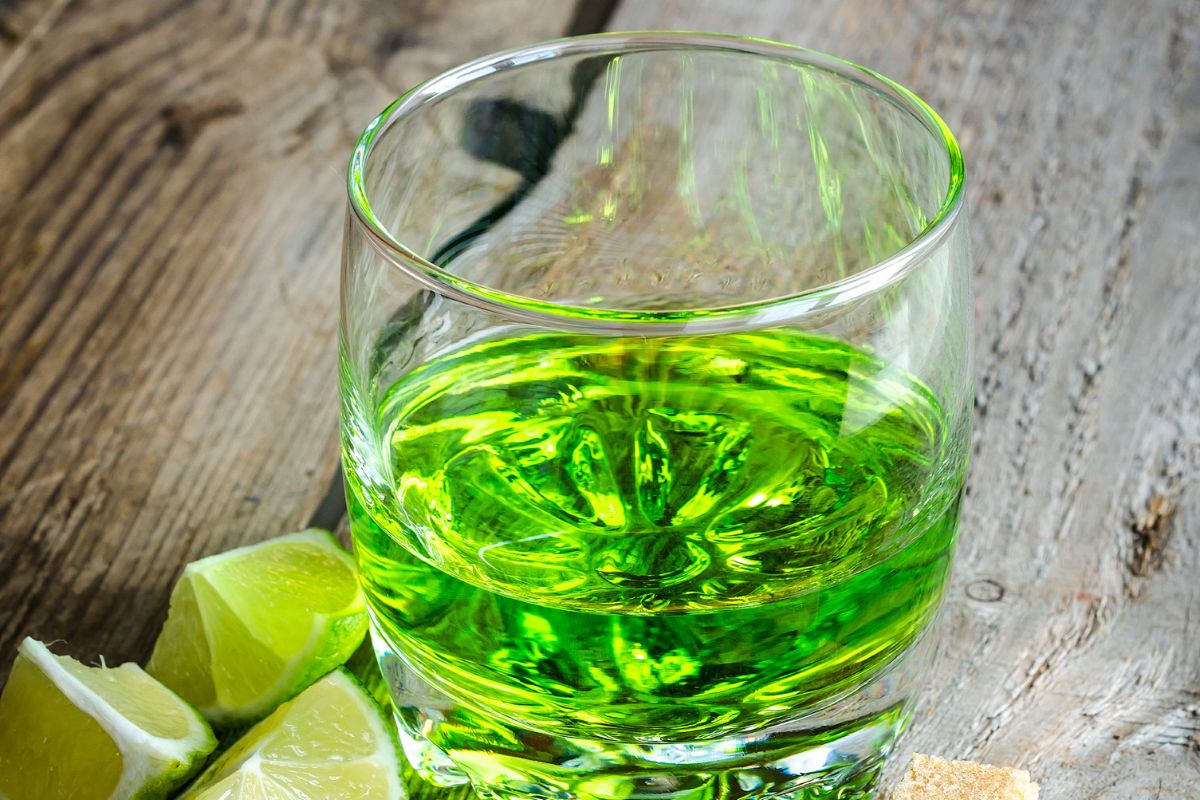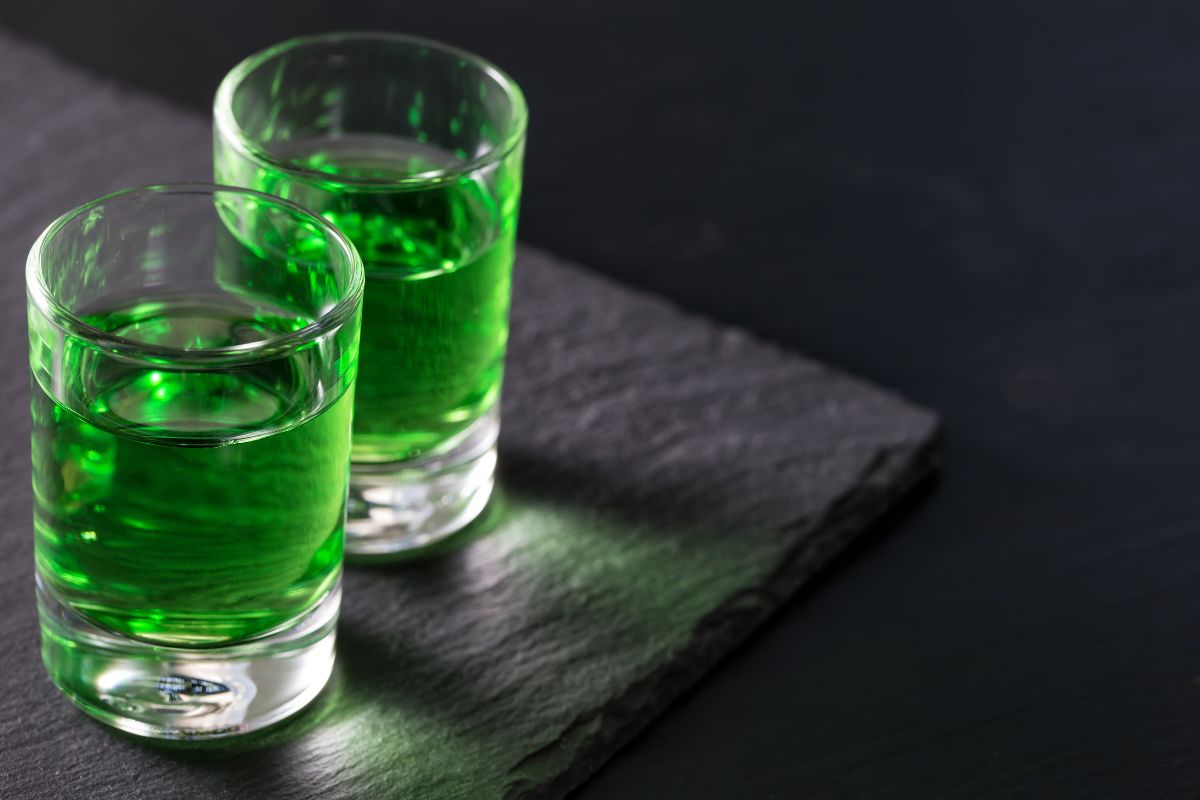Absinthe, often referred to as the “Green Fairy,” is a unique and intriguing spirit that has captivated the imagination of artists, writers, and enthusiasts for centuries.

Known for its vibrant green color, strong herbal aroma, and association with Bohemian culture, absinthe has a rich history and an air of mystery surrounding it.
In this article, we delve into the world of absinthe so that whether you’re a curious newcomer or a seasoned connoisseur, you’ll be sure to be intrigued by the fascinating story and allure of absinthe!
All About Absinthe
Absinthe is a highly alcoholic spirit known for its distinct green color and strong herbal flavor. It is traditionally made from a combination of botanicals, primarily Artemisia absinthium (commonly known as wormwood), anise, and fennel.
These key ingredients contribute to the unique taste and characteristic aroma of the drink.
Originating in the late 18th century in Switzerland, absinthe gained popularity in the 19th and early 20th centuries, particularly in European Bohemian circles.
It became synonymous with the creative and artistic movements of the time, attracting writers, painters, and intellectuals who believed in its stimulating and creative effects.
The production process of absinthe involves distilling a neutral alcohol base with a blend of herbs and botanicals. The exact recipe and composition of these botanicals can vary among different absinthe producers, resulting in variations in flavor and potency.
Once distilled, absinthe is typically bottled at a high alcohol percentage, ranging from 45% to 75% ABV (alcohol by volume).
One distinctive feature of absinthe is its louche effect.
When water is added to absinthe, either by slowly dripping it over a sugar cube placed on an absinthe spoon or by using a specialized absinthe fountain, the drink turns cloudy and opalescent, creating a mesmerizing visual display.
It is important to note that historically, absinthe was associated with a controversial reputation due to claims of hallucinogenic effects caused by the presence of thujone, a compound found in wormwood.
However, modern production methods and regulations have greatly limited the thujone content in absinthe, making it safe for consumption and eliminating the hallucinogenic claims.
Today, absinthe is enjoyed as a sipping spirit or used as an ingredient in cocktails. Its complex flavor profile makes it a unique and intriguing choice for those seeking a distinctive drinking experience.
The History Of Absinthe
As mentioned, the history of absinthe can be traced back to the late 18th century in Switzerland, where it was initially developed as a medicinal elixir.

The drink’s key ingredient, wormwood, was believed to have healing properties and was used to treat a variety of ailments, including digestive issues and fever.
Over time, the drink became more widely available and grew in popularity, particularly in France.
In the mid-19th century, absinthe began to attract a more Bohemian following, particularly among artists and writers in Paris. The drink’s stimulating and creative effects were believed to enhance artistic inspiration and fuel creativity.
The French poet Charles Baudelaire even referred to absinthe as “the muse of poets.”
Despite its growing popularity, absinthe faced significant opposition and controversy.
In the late 19th and early 20th centuries, some people began to associate the drink with violent and destructive behavior, and it was blamed for causing hallucinations, insanity, and even murder.
These claims were largely unfounded, and many of them were based on misconceptions and sensationalized media reports. However, they led to a wave of anti-absinthe sentiment and campaigns against the drink.
In 1915, absinthe was banned in France, and other countries soon followed suit, including the United States. The ban lasted for several decades, and it wasn’t until the late 20th century that absinthe began to make a comeback.
In the 1990s, the European Union lifted its ban on absinthe, and in 2007, the United States followed suit, allowing the sale and production of absinthe with certain restrictions.
The Taste Of Absinthe
The taste of absinthe is often described as complex and layered, with a range of herbal and botanical flavors that come from its various ingredients, including wormwood, anise, fennel, and other botanicals.
The dominant flavor in absinthe is typically anise, which gives the drink a distinct licorice-like taste. There are also often subtle notes of other flavors present as well, such as mint, coriander, and even citrus.
The taste can be quite polarizing, with some people loving its complex flavor profile and others finding it too strong or overwhelming.
However, for those who appreciate its distinctive taste and cultural significance, absinthe can be a fascinating and enjoyable spirit to explore.
Final Thoughts
Absinthe is a spirit with a rich and intriguing history that continues to captivate the imagination of enthusiasts around the world.
From its origins as a medicinal elixir to its association with Bohemian culture and artistic inspiration, absinthe has carved its place in the world of spirits.
Absinthe’s complex flavor profile, characterized by the dominant taste of anise and a blend of herbal and botanical notes, offers a unique and memorable drinking experience.
The ritual of preparing absinthe, including the mesmerizing louche effect, adds to its allure and creates a sense of ceremony around enjoying this spirit.
While absinthe had faced controversy and even bans in the past due to unfounded claims of hallucinogenic effects, it has regained its rightful place in the world of spirits.
Modern production methods and regulations ensure its safety and eliminate the myths surrounding its consumption.
Whether sipped neat, enjoyed with the traditional sugar and water ritual, or incorporated into creative cocktails, absinthe provides a distinct taste that appeals to those seeking a flavorful and adventurous drinking experience.
As you explore the world of absinthe, you will uncover its historical significance, the craftsmanship behind its production, and the cultural impact it has had on art, literature, and the Bohemian lifestyle.
So raise a glass of this vibrant green spirit and immerse yourself in the fascinating journey of absinthe. Cheers!
- How To Reheat A Cheesesteak - November 5, 2023
- What Are Three Must Have Kitchen Knives? - September 22, 2023
- How To Protect Edges Of Pie Crust - June 15, 2023








